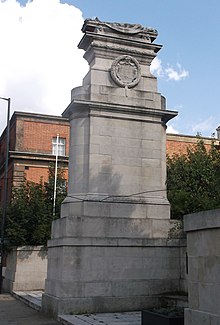| Midland Railway War Memorial | |
|---|---|
| United Kingdom | |
 | |
| For employees of the Midland Railway killed in the First World War | |
| Unveiled | 15 December 1921 |
| Location | 52°54′56″N 01°27′53.2″W / 52.91556°N 1.464778°W Midland Road, Derby |
| Designed by | Sir Edwin Lutyens |
| Commemorated | 2,833 |
TO THE BRAVE MEN OF THE MIDLAND RAILWAY WHO GAVE THEIR LIVES IN THE GREAT WAR | |
Listed Building – Grade II* | |
| Official name | Midland Railway War Memorial |
| Designated | 24 February 1977 |
| Reference no. | 1228742 |
The Midland Railway War Memorial is a First World War memorial in Derby in the East Midlands of England. It was designed by Sir Edwin Lutyens and unveiled in 1921. The memorial commemorates employees of the Midland Railway who died while serving in the armed forces during the First World War. The Midland was one of the largest railway companies in Britain in the early 20th century, and the largest employer in Derby, where it had its headquarters. Around a third of the company's workforce, some 23,000 men, left to fight, of whom 2,833 were killed.
Standing on Midland Road, within sight of Derby railway station and backing on to the garden of the Midland Hotel, the memorial consists of a cenotaph partially enclosed by a screen wall on three sides. Affixed to the wall are bronze plaques listing the names of the dead. On either side of the cenotaph is the Midland's coat of arms, enclosed in a laurel wreath. The crest is surmounted by a catafalque with sculpted lion heads at the corners, supporting the recumbent effigy of a soldier, covered by a coat. Lutyens renders the soldier anonymous by lifting him high above eye level, allowing the viewer to believe it could be somebody they knew.
The memorial was unveiled on 15 December 1921. The Midland also published a book of remembrance, a copy of which was sent to the families of all the men listed on the memorial. Later in the 1920s, the Midland Railway was amalgamated into a larger company and Derby's importance as a railway centre waned. Today, the memorial stands in a conservation area and is a grade II* listed building. It was repaired in 2010 after several of the bronze plaques were stolen and later recovered.